
The Traffic Accident Reconstruction Origin -Approach Angles Solution-


The Traffic Accident Reconstruction Origin -Approach Angles Solution-
|

|
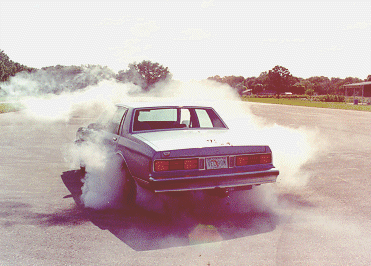 Since the driver is identified, the central issue in this matter is
how can you associate the marks in the road with a particular vehicle in the suspects back yard. Also
how can you describe the vehicles behavior while it created these marks?
Since the driver is identified, the central issue in this matter is
how can you associate the marks in the road with a particular vehicle in the suspects back yard. Also
how can you describe the vehicles behavior while it created these marks?To those of us who perhaps misspent a portion of our youth, these marks are obvious. Painted onto the road as 'doughnuts' by an aggressive driver you may be able to picture their generation clearly based on your own personal experiences. It is a larger task to understand how these types of marks are made. Next you must be able to relate the marks to lay persons in a way that can meet the legal burden of 'beyond a reasonable doubt.' So a technical explanation of these pieces of evidence is in order.
The evidence for this matter can be divided into three groups. Roadway, vehicles and witness statements. Because of their unbiased nature, physical evidence will be examined first, then supported with the witnesses statements. Lastly, theories will be tested by attempting to duplicate the evidence and circumstances of the incident.
A. THE PLAN TO EXAMINE THE PHYSICAL EVIDENCE FROM ROADWAY
ACCOUNTING FOR THE PHYSICAL EVIDENCE
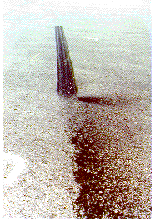
Extreme Example of an Acceleration Scuff Mark note tire shards in foreground |
The marks left in the roadway are a very specific type of mark. They are a
derivative of the classic
'acceleration scuff' mark. They are made by a tire that is spinning rapidly on the roadway surface. We
know that an acceleration scuff mark is caused by a driver, applying power to the drive tires in excess
of the available traction. The point is reached where the drive tires are spinning freely and this is
usually accompanied by some tire noise and the generation of thick white smoke from the tires while
the marks are being made. This condition may be maintained until it is interrupted by driver
discretion, vehicle limitations or roadway dimensions.
|
They are distinctive for three reasons.
1. WHY ARE THE MARKS LONG?
Conclusion: The driver had his foot hard on the gas pedal of a powerful car for an extended period of time while a constant low speed maneuver was being done.
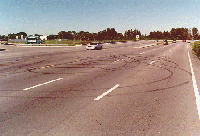 Explanation: If all the marks were straightened out, they would
give a total scuff length of approximately 314 feet. Five pairs of marks in circles whose diameter is
20', 5(loops) x (3.14(pi) x 20(foot diameter of circle)) = 314' (total length of marks). If these marks
were straight, one might expect a single long straight line decreasing in intensity near the end as the
vehicle accelerated and vehicle speed began to approach tire rotation speed. This is because even
though the tires are spinning, they are still generating forces that would normally cause the vehicle to
accelerate.
Explanation: If all the marks were straightened out, they would
give a total scuff length of approximately 314 feet. Five pairs of marks in circles whose diameter is
20', 5(loops) x (3.14(pi) x 20(foot diameter of circle)) = 314' (total length of marks). If these marks
were straight, one might expect a single long straight line decreasing in intensity near the end as the
vehicle accelerated and vehicle speed began to approach tire rotation speed. This is because even
though the tires are spinning, they are still generating forces that would normally cause the vehicle to
accelerate.
Because of the tight radius of these marks it is evident that these marks were not made by a vehicle traveling at a high speed. Also because they repeat in similar and tight radiuses, we can presume that the vehicle speed was relatively constant and low throughout the time when these marks were being made. Because of these things, it would have take some time to create these marks. 15 to 30 seconds would be the expected amount of time.
Even though traveling at a low speed, this act would have required an unusual vehicle. It would either need to have a tremendous power to weight ratio to overcome the available traction, or a weight load in such a manner as to unload the drive tires allowing them to spin and generate the marks.
2. WHY ARE THE MARKS IN PAIRS?
Conclusion: The car that left the marks was equipped with a Posi-Traction locked type of drive axle. Explanation: Throughout the length of these marks on the roadway, there is a definite association with another nearby mark. When one mark moves in one direction, a nearby mark follows. As one mark lightens up, so generally does a corresponding nearby mark.
The paired marks need to be addressed from a mechanical point of view. What mechanical option would the offending vehicle have needed to account for this condition?
Most vehicles on the road today have a conventional 'open' type of differential assembly. This type of unit is a mechanical arrangement of gears that ensures that equal amounts of torque are transmitted to the ground through both of the drive tires on an axle at the same time. This open type of drive system freely allows the tires to spin at different rates on either side of the axle while transmitting power to both. This permits a vehicle to go around a corner and each tires speed will compensate for the different radiuses of the different tracks each tire follows around a corner.
These open drive axles display several common characteristics. If one drive tire's traction is compromised (as if being in mud or snow), it can do no work. In this condition, the drive tire still on the good surface will also do no work; hence the vehicle is stuck. Another characteristic is that when raised into the air as if on a mechanics lift, with the drive line locked as if in park, if one drive tire is spun by hand, the other drive tire will rotate in the opposite direction. The tire will turn with little effort.
An open rear end can display two acceleration scuff marks but this is usually a short lived event. As one tire breaks traction it begins to spin. This transition to sliding friction and it's corresponding lower traction usually ensures that the other tire does not spin at all. This is the reason for most cars spinning only one tire during hard acceleration.
The opposite of the open rear end is the Posi-traction. Because this name is actually is a trademark of a particular gear company, other names imply similar action (limited slip, Detroit locker, or other names). These other types of rear ends augment the normal differential drive assembly with an arrangement of clutches or ratchets that ensure that both drive tires always drive the ground regardless of the others rotation. These are available in many types of vehicles as an option, but they are not a popular option.
These drive axles are somewhat of a liability. They are nosier, tending to groan and clunk in a tight corner as the clutches slip. They also require more frequent maintenance than an open unit. Because a posi-traction axle drives both tires, in a corner when one tire loses traction the other may do so at the same time. The result is usually a loss of the entire drive axles lateral contribution to the vehicles control. A skid usually follows.
On the contrary, as an open axle reaches its limit of adhesion, the opposite tire on the same axle will still maintain lateral traction increasing the drivers control. This will ensure that the vehicle tracks true even though one tire may be spinning due to excessive throttle application. This condition will make the vehicle safer and more predictable with the open style of differential.
During an examination, a posi-traction axle can be identified because when raised into the air as if on a mechanics lift, with the drive line locked as in park, you will not be able to spin the rear tires or it will be very hard to do so and if so the other might still rotate in the opposite direction. So the ease of rotation is the key to identification.
WHY ARE THE MARKS CIRCULAR IN NATURE?
Conclusion: The car that made the marks was a rear wheel drive vehicle being steered in circles as the rear tires yawed behind.
As many as five circles are visible on the roadway along with one 'S' shape (see exhibit #1). The radius of these marks appears shorter than the turning radius of most vehicles. The S shape implies a change in vehicle direction may have occurred during this maneuver.
These marks could not have been left by a front wheel drive vehicle. If a FWD vehicle generated enough power at the drive wheels to lose traction with both wheels, it would be unable to steer. This is because if the front tires were spinning, they could do no steering. Consequently, the marks would be long and relatively straight.
A rear wheel drive, posi-traction car, made to spin it's rear tires while turning would enter into a Yaw like turn. The rear tires would track outside the front tires and this would tighten up the circles being made by the car as it turned. The forces of the spinning tires will still push the car forward but the lateral acceleration will balance this resulting in no significant change in speed.
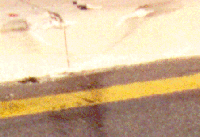 Look at the damage to the curb. It has a measurable chord that
could be used to determine the diameter of the wheel that made the mark. The vehicle that made the
mark probably suffered damage to the rim and bruising to the tire. This would have been a left rear
tire. Look at the vehicle track, tire section width, and number of blocks on the tread for a match to the
vehicle. This exhibit also shows a puddle of fluid has leaked onto the road. This may be axle
lubricant. This may have happened if the axle or drive shaft broke when the vehicle struck the
curb.
Look at the damage to the curb. It has a measurable chord that
could be used to determine the diameter of the wheel that made the mark. The vehicle that made the
mark probably suffered damage to the rim and bruising to the tire. This would have been a left rear
tire. Look at the vehicle track, tire section width, and number of blocks on the tread for a match to the
vehicle. This exhibit also shows a puddle of fluid has leaked onto the road. This may be axle
lubricant. This may have happened if the axle or drive shaft broke when the vehicle struck the
curb.
B. PHYSICAL EVIDENCE FROM VEHICLES
We are looking for a high horsepower, rear wheel drive vehicle, with a Posi-traction axle, and rubber shards in the wheel wells.
We expect the track and tire characteristics of one of the vehicles to match the physical evidence found on the roadway.
We could expect damage to the left rear tire and wheel assembly. It is also possible that the vehicle suffered damage to its axle or axle housing.
C. WITNESS STATEMENTS
The witness statements are entirely consistent with all of the element of the hypothesis.
THE CAR
The car used for this test was a specially modified Chevrolet Caprice. It outwardly resembles the sedan used by police agencies around the country several years ago. This particular Caprice has been modified by increasing the amount of horsepower the engine generates. This was accomplished by the owner exchanging the original 305 cubic inch engine for a modified 454. This and other associated changes raised the available horsepower from about 165 to 325. Additionally this vehicle had its rear axle exchanged for one of the posi-traction types. For the test, the owners normal rear tires were replaced. These tires were different from each other to later aid in mark identification. For reference purposes, this car is about as quick as a new Z-28 (14.3 @96 mph 1/4 mile times).
THE DRIVERS ACTIONS
The car was placed in low gear of a 4 speed automatic transmission. The brake pedal was applied with the drivers left foot to hold the car while the gas pedal was then applied with the right foot to begin spinning the rear tires. Once the rear tires were spinning regularly, the front wheel was turned completely to left lock. The brake pedal was then released. Engine RPM was maintained by throttle modulation to ensure constant tire slippage.
THE EVENT
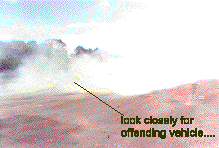
|
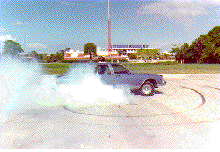
|
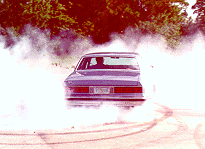
|
THE ROADWAY EVIDENCE GENERATED
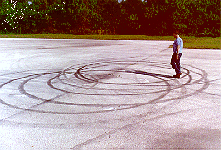
Marks similar to those of the questioned case were made.
THE VEHICLE EVIDENCE
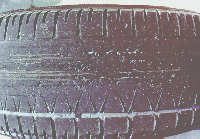 The vehicle tires were quickly reduced to scraps. The rear tires separated and came apart within one
minute. The quarter-panels behind the drive tires and the wheel wells were covered with hundreds of
small pieces of rubber that had become separated from the tires.
The vehicle tires were quickly reduced to scraps. The rear tires separated and came apart within one
minute. The quarter-panels behind the drive tires and the wheel wells were covered with hundreds of
small pieces of rubber that had become separated from the tires.
The driver had his foot hard on the gas pedal of a powerful car for an extended period of time while a constant low speed maneuver was being done. The car that left the marks was equipped with a Posi-Traction locked type of drive axle. The car that made the marks was a rear wheel drive vehicle being steered in circles as the rear tires yawed behind.
Two vehicles in the suspects yard can be eliminated immediately. The Tercel, though smoking is not a candidate because it is front wheel drive. The Mitsubishi is either 4 wheel drive or front wheel drive, so it too is eliminated. This leaves the Mustang or Camaro. The next step should be an assesment of their power. This maneuver clearly requires V8 power. The damage to the right rear wheel-tire, and rubber shards should cinch this identification.
Bob Wright is a sergeant with The Martin County Sheriffs Office in Stuart Florida. He has spent many years assigned to the Traffic Division as an accident investigator. He has recieved advanced accident investigation training at IPTM. He is currently in charge of the training division. He trains in in vehicle related law enforcement topics. He is also an enthusiast competing in autocross and some minor league stock car racing. He can be reached at bwright@treco.net.
|
Copyright ©
|